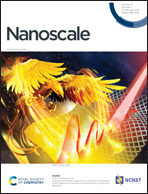Improving the thermoelectric performance of Cu2SnSe3via regulating micro- and electronic structures†
Abstract
As a p-type thermoelectric material, Cu2SnSe3 (CSS) has recently drawn much attention, with its constituents being abundant and free of toxic elements. However, the low electrical conductivity σ and thermopower S of CSS prohibit its thermoelectric performance. Here, we show that through mechanical milling, a 14 times increase in σ, around a 2-fold rise in S and a 40% reduction in the lattice thermal conductivity κL (at 300 K) can be achieved, amazingly. Microstructural analysis combined with first-principles calculations reveal that the increased σ originates from the generated Sn vacancies  , Se dangling bonds and the reconstructed Cu–Sn-terminated acceptor-like surface states; while the enhanced S comes mainly from the enhanced density of states effective mass caused by the Sn vacancies. In addition, the generated Sn vacancies and the in situ formed SnO2 nanoparticles give rise to strong phonon scattering, leading to the reduced κL. As a result, a maximum ZTm = 0.9 at 848 K is obtained for the CSS specimen milled for 2 h, which is ∼3 times larger than that of CSS milled for 0.5 h.
, Se dangling bonds and the reconstructed Cu–Sn-terminated acceptor-like surface states; while the enhanced S comes mainly from the enhanced density of states effective mass caused by the Sn vacancies. In addition, the generated Sn vacancies and the in situ formed SnO2 nanoparticles give rise to strong phonon scattering, leading to the reduced κL. As a result, a maximum ZTm = 0.9 at 848 K is obtained for the CSS specimen milled for 2 h, which is ∼3 times larger than that of CSS milled for 0.5 h.



 Please wait while we load your content...
Please wait while we load your content...